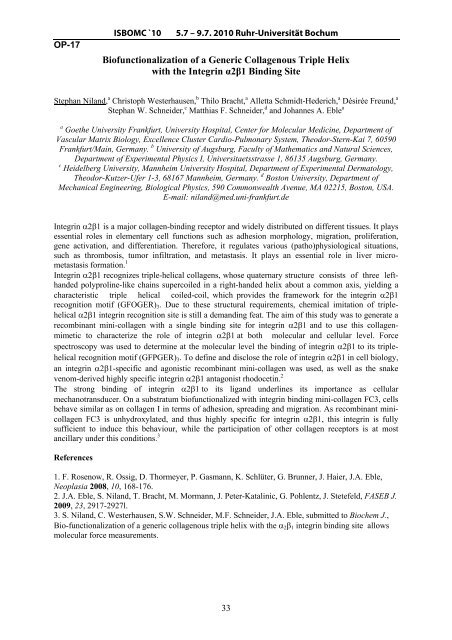Book of Abstracts - Ruhr-Universität Bochum
Book of Abstracts - Ruhr-Universität Bochum
Book of Abstracts - Ruhr-Universität Bochum
Create successful ePaper yourself
Turn your PDF publications into a flip-book with our unique Google optimized e-Paper software.
OP-17<br />
ISBOMC `10 5.7 – 9.7. 2010 <strong>Ruhr</strong>-<strong>Universität</strong> <strong>Bochum</strong><br />
Bi<strong>of</strong>unctionalization <strong>of</strong> a Generic Collagenous Triple Helix<br />
with the Integrin α2β1 Binding Site<br />
Stephan Niland, a Christoph Westerhausen, b Thilo Bracht, a Alletta Schmidt-Hederich, a Désirée Freund, a<br />
Stephan W. Schneider, c Matthias F. Schneider, d and Johannes A. Eble a<br />
a Goethe University Frankfurt, University Hospital, Center for Molecular Medicine, Department <strong>of</strong><br />
Vascular Matrix Biology, Excellence Cluster Cardio-Pulmonary System, Theodor-Stern-Kai 7, 60590<br />
Frankfurt/Main, Germany. b University <strong>of</strong> Augsburg, Faculty <strong>of</strong> Mathematics and Natural Sciences,<br />
Department <strong>of</strong> Experimental Physics I, Universitaetsstrasse 1, 86135 Augsburg, Germany.<br />
c Heidelberg University, Mannheim University Hospital, Department <strong>of</strong> Experimental Dermatology,<br />
Theodor-Kutzer-Ufer 1-3, 68167 Mannheim, Germany. d Boston University, Department <strong>of</strong><br />
Mechanical Engineering, Biological Physics, 590 Commonwealth Avenue, MA 02215, Boston, USA.<br />
E-mail: niland@med.uni-frankfurt.de<br />
Integrin ���� is a major collagen-binding receptor and widely distributed on different tissues. It plays<br />
essential roles in elementary cell functions such as adhesion morphology, migration, proliferation,<br />
gene activation, and differentiation. Therefore, it regulates various (patho)physiological situations,<br />
such as thrombosis, tumor infiltration, and metastasis. It plays an essential role in liver micrometastasis<br />
formation. 1<br />
Integrin ���� recognizes triple-helical collagens, whose quaternary structure consists <strong>of</strong> three lefthanded<br />
polyproline-like chains supercoiled in a right-handed helix about a common axis, yielding a<br />
characteristic triple helical coiled-coil, which provides the framework for the integrin ����<br />
recognition motif (GFOGER)3. Due to these structural requirements, chemical imitation <strong>of</strong> triplehelical<br />
���� integrin recognition site is still a demanding feat. The aim <strong>of</strong> this study was to generate a<br />
recombinant mini-collagen with a single binding site for integrin ���� and to use this collagenmimetic<br />
to characterize the role <strong>of</strong> integrin �����at both molecular and cellular level. Force<br />
spectroscopy was used to determine at the molecular level the binding <strong>of</strong> integrin �����to its triplehelical<br />
recognition motif (GFPGER)3. To define and disclose the role <strong>of</strong> integrin �����in cell biology,<br />
an integrin ����-specific and agonistic recombinant mini-collagen was used, as well as the snake<br />
venom-derived highly specific integrin ���� antagonist rhodocetin. 2<br />
The strong binding <strong>of</strong> integrin �����to its ligand underlines its importance as cellular<br />
mechanotransducer. On a substratum bi<strong>of</strong>unctionalized with integrin binding mini-collagen FC3, cells<br />
behave similar as on collagen I in terms <strong>of</strong> adhesion, spreading and migration. As recombinant minicollagen<br />
FC3 is unhydroxylated, and thus highly specific for integrin ����, this integrin is fully<br />
sufficient to induce this behaviour, while the participation <strong>of</strong> other collagen receptors is at most<br />
ancillary under this conditions. 3<br />
References<br />
1. F. Rosenow, R. Ossig, D. Thormeyer, P. Gasmann, K. Schlüter, G. Brunner, J. Haier, J.A. Eble,<br />
Neoplasia 2008, 10, 168-176.<br />
2. J.A. Eble, S. Niland, T. Bracht, M. Mormann, J. Peter-Katalinic, G. Pohlentz, J. Stetefeld, FASEB J.<br />
2009, 23, 2917-2927l.<br />
3. S. Niland, C. Westerhausen, S.W. Schneider, M.F. Schneider, J.A. Eble, submitted to Biochem J.,<br />
Bio-functionalization <strong>of</strong> a generic collagenous triple helix with the ���� integrin binding site allows<br />
molecular force measurements.<br />
33
















